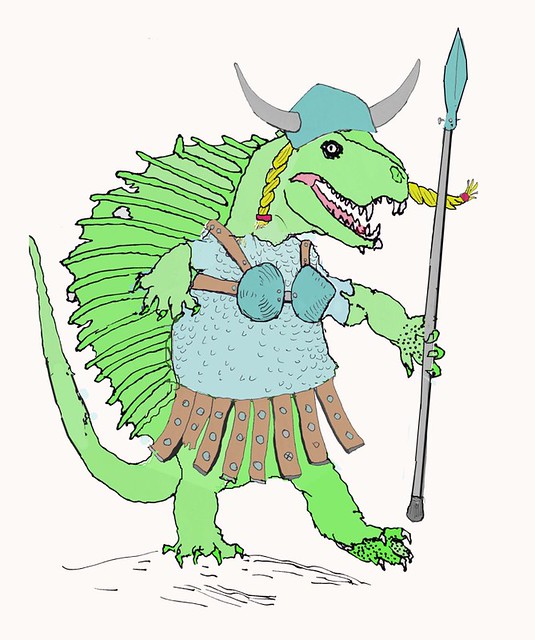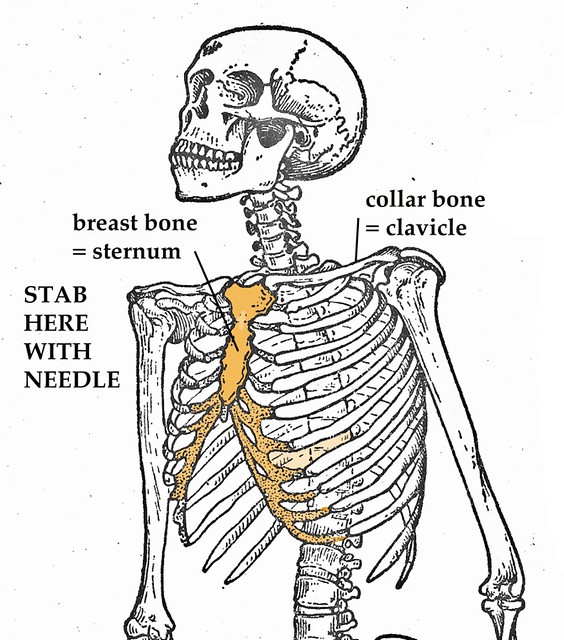HUZZAH! We have the missing bone: the largest unit in the Dimetrodon skeleton, the one bony element we never hoped to find! We thought weʼd have to sculpt a fake one, but now we have the real thing — the INTERCLAVICLE.
Whatʼs that you say? Never heard of an interclavicle? Its common name is the breast-plate. Most of our ancient Permian critters, both reptile and amphibian, have breast-plates.
Our Dimetrodon wasnʼt armored on his chest like Bugs Bunny playing the Valkyrie in “Whatʼs Opera Doc.” The true breast-plate was a long, narrow, strong beam of bone that was fixed to the chest along the midline. Itʼs got a long “stem” in back, and an expanded “bowl” up front. The interclavicle is so named because it was attached to the big collar bones, also known as clavicles. Hereʼs a view of our new find, plus a diagram of how the clavicles and interclavicle attach to each other and to the shoulder blades:
 The diagram is drawn as if the entire shoulder were flattened by a bulldozer so all the
The diagram is drawn as if the entire shoulder were flattened by a bulldozer so all the
bones are in one plane. Weʼve color-coded the bones so
the osteologically challenged donʼt get frightened.
Our new specimen is held by the volunteer who found it.
To understand the architectural implications of the interclavicle, we must decide on our favorite role played by Uma Thurman. (We just love her — we even have a bone bed named “Uma”). We are impressed with Uma as “Ulla”, the Swedish femme fatale/housekeeper/tidying-upper in The Producers, but our choice would be Mia, the gangster girlfriend in Pulp Fiction.
Mia explains the interclavicle in the famous scene where she is stabbed in the heart with a huge syringe wielded by John Travoltaʼs character, who is trying to resuscitate her after an unfortunate mix-up in recreational prescriptions.
Travolta illustrates an emergency procedure: the needle must be thrust hard through the human breast-bone and into the cardiac cavity to jump-start the heart.
(Note: Do not try this at home. Ever. Not even with the pet gerbil.)
Mia does regain consciousness, with the syringe still sticking out of her breast-bone. (The technical name for her breast-bone is sternum.)
But let’s get to the osteological point. The breast-bone, aka sternum, is NOT the same as the breast-plate, aka interclavicle. Our human breast bone is part of our rib-cage. Itʼs in the middle of our chest and ties the right and left side of our ribs together. Itʼs made from rather soft bone material (so you can, in fact, get a needle through). The turkey breast-bone is the same unit, a sternum, but is much bigger and harder.
Next Thanksgiving, poke around with your fork to see how the birdʼs ribs attach to the sternum.
But back to Ms. Thurmanʼs sternum. Scrutinize this diagram; it shows Umaʼs skeleton:
Examine the rib cage and breast-bone. Note the collar bones (clavicles). They are slender, graceful bones with swivel joints where they attach to the sternum.
Iʼll give you a minute.
Got it? Now repeat after me: “Sternum ties ribs together; clavicles are slender and have swivel joints.”
Okay. Now look at this chest, from a close kin of Dimetrodon. The clavicles are wide bones, much, much broader than ours. See the interclavicle? Itʼs not attached to the ribs. It lies under the sternum and has a stiff overlapping joint with the clavicles. The entire clavicle/interclavicle apparatus makes an extraordinarily strong, T-shaped apparatus, a rigid support for the shoulders.
In the Dʼdon clan, the interclavicle is immensely long, far longer than the thigh. If you probe around your own chest you will, I guarantee, not find an interclavicle.
Hereʼs what our chest would look like if we did have one and a set of broad clavicles to match. (If you do find an interclavicle on yourself, call the 800 number at the bottom of the blog).
We primates donʼt have an interclavicle or wide clavicles attached stiffly to the interclavicle. Neither do cats, dogs, horses, goats, guinea pigs, elephants, ʻpossums, raccoons, dolphins, aye-ayes or numbats (Google those last two). No normal mammal has an interclavicle today. We lost them in the Late Jurassic, about 150 million years ago.
So, what did the interclavicle/clavicle unit do in Dimetrodon, et al? Two things.
One, it helped armor the chest. Since it was dense, hard bone, the interclavicle plus clavicles protected heart and lungs from blows delivered by an opponent. In other words, the bones acted as a chest-protector. And that means all members of a Permian baseball team would be outfitted to play catcher (think about it).
Two, it was the attachment for the biggest muscle in the front limb, the pectoralis. Dimetrodon and its friends and relations were all really buff. The pecs were huge. We know that from the bump of bone on the upper arm, the “delto-pectoral crest”, where the pecs attached. Feel the inside of your armpit. The muscle here is the pectoralis. If you were a Dʼdon, the pecs would be four times thicker.
Our new, perfect Dimetrodon interclavicle shows clearly where the pecs attached all along the “stem.” By the way, the buff pecs explain why this bone gets chewed to bits by scavengers nearly every time. The interclavicle is so meaty that it is the first place to bite if you are hungry. Check out this sketch of a Dʼdon relativeʼs chest.
A couple of final points and inquiries. There are very few mammal species alive now who have interclavicle/clavicle apparatus like a Dimetrodonʼs. Who are they? Why is their motherhood so weird? They give us a clue about why most of us Mammalia have lost the bone.
Homework: Move your left shoulder blade up and down and around, as you feel your left collar bone with your right hand. Could Dimetrodon do that? Massage a cat or dog while they are relaxed. See how the shoulder blade moves? Could a Dʼdon or its relatives do that? Ride a horse. Feel the shoulder blade move. Is such mobility possible in an early Permian reptile? Now do you have a notion about why we advanced mammals lost the stiff interclavicle/clavicle arrangement?
Lastly and more importantly, what if Uma Thurmanʼs characterʼs Mia were equipped with a proper Dʼdon interclavicle composed of hard, dense bone? She would not have been resuscitated. The needle would have broken off.













